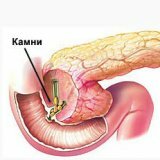Reactive pancreatitis: symptoms

Pancreatitis is a group of diseases, the common feature of which is inflammation of the pancreas. In the course of the disease, pancreatitis is divided into acute, chronic and reactive, they differ not only in the duration of the course, but also in clinical signs-that is, patient complaints and symptoms. Let's look at what reactive pancreatitis is: symptoms and causes.
Reactive pancreatitis is the least dangerous form of the disease, it develops as a reaction usually to inaccuracies in nutrition( abundant fatty foods).Of course, not everyone reacts in this way to a feast with mayonnaise salads and fried meat, but sharp, fried and fatty foods disrupt the normal functioning of the pancreas. The harmful influence on this body is also exerted by excessive craze for alcohol, overeating, malnutrition and constant stress. From all this, the production of digestive enzymes is significantly increased, the pressure in the duodenum is increased, the outflow of pancreatic juice is hampered, which provokes the development of an attack of pancreatitis.
In addition, an attack can occur due to cirrhosis of the liver, peptic ulcer, blockage of the gallstone common to the gallbladder and pancreas duct. Cases of traumatic reactive pancreatitis are known - pancreatic tissue damage is damaged, pancreatic juice can not enter the duodenum, so the same process begins as in ordinary pancreatitis - self-destruction of pancreatic tissue.
In case of an attack of pancreatitis, we advise you to immediately consult a doctor. Do not treat this disease comically - the disease is dangerous to health. During an attack, the necrosis of the pancreas, the formation of cysts and abscesses, which requires urgent surgical intervention.
Pancreatitis reactive: symptoms
In severe forms of pancreatitis, lowers blood pressure, dehydration occurs, the patient can even lose consciousness. A typical symptom of reactive pancreatitis is severe pain, its localization depends on which part of the pancreas is affected. If the head of the organ is inflamed, the pain is concentrated in the right hypochondrium, if the organ body is involved in the pathological process - in the epigastric region, and if the tail is in the left hypochondrium. When the whole gland is inflamed, the pain is shinier.
But pain is not the only sign of pancreatitis. Often, patients complain of loss of appetite and aversion to fatty foods, and if pancreatitis is acute, the symptoms are as follows: belching, severe attacks of nausea, increased salivation and bloating.



